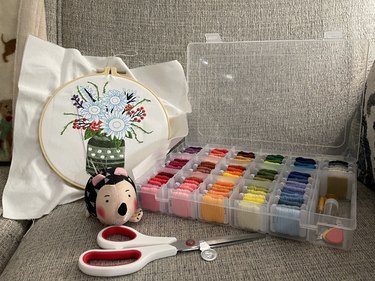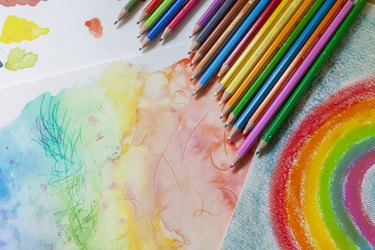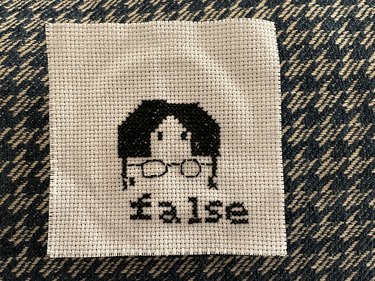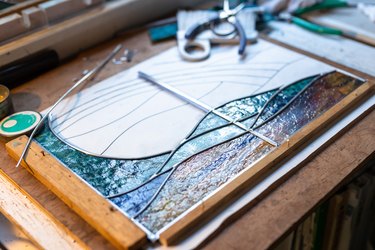Editor's Note: This story contains mentions of trauma, mental illness and cancer.

In one of my favorite songs, English artist Frank Turner sings, "Now who'd have thought that after all / something as simple as rock 'n' roll would save us all." In my own life, I might amend these lyrics to say, "Now who'd have thought that after all / something as simple as crafting would save me." Following the loss of my mom, crafting became an unexpected healing force in my life and provided a tangible way to process grief, anxiety and trauma. Above all, it has allowed me to create meaningful new connections with my mom—even in her absence.
Video of the Day
Video of the Day
I've struggled with difficulties like clinical anxiety, depression and panic attacks for much of my life, but my mom's endometrial cancer diagnosis in 2016 only worsened matters. A year of surgery, chemo and radiation initially helped my mom, but the cancer spread to her lymph nodes in 2018. Her condition progressively worsened. During the early days of the pandemic, while others were making sourdough or catching up on TV shows, I balanced my time between online work and assisting my dad as Mom's caregiver.

We lost my sweet mom on February 5, 2021. As a 31-year-old, my mother's death forced me to face scenarios and decisions that seemed premature. I felt like a child who had to grow up too fast while enduring the sobering realities of cancer, death and all-consuming grief.
I've since learned that grief is not linear. It ebbs and flows, sometimes a gentle nudging in the brain and other times an overwhelming wave. After a particularly intense grief-induced mental health episode in the spring of 2022, my therapist and doctor recommended that I enroll in a two-week partial hospitalization program (PHP): It's a "middle ground" solution between outpatient therapy and inpatient hospitalization.
I attended PHP classes alongside other students for six hours a day, five days a week. One daily class was called Enrichment, more commonly known as art therapy. We were presented with projects like painting, making bracelets or key chains and creating paper crafts. We colored on printable sheets or completed word searches and crossword puzzles. After muddling through exhausting grief and anxiety, this enrichment time allowed my brain to simply settle and take a break.

In retrospect, it's no surprise that these classes felt so good. According to Kim Virrueta, an associate marriage and family therapist in Southern California, there's a clear connection between mental health and artistic enrichment. "Positive psychology proposes that when someone does something they really love, they lose track of time because they feel so engrossed in the activity," she explains. "This is also known as a 'flow state.'" This flow state is akin to feeding the soul. "Our brains release feel-good chemicals when we do something we enjoy, such as getting into a flow state with crafting," Virrueta says. "These chemicals are shown to improve mood, reduce depressive feelings and help calm the nervous system."
I've never considered myself terribly artistic, but I noticed these feelings of calm—this "flow state"— right away during enrichment sessions. While putting colored pencil to paper or paintbrush to wood, I could simply let go. As I embraced crafting, I noticed that the process was both mindful and mindless—I could concentrate on the task at hand while letting other thoughts come and go. The simple, repetitive movements of folding paper or mixing colors were freeing.

As a bit of a perfectionist, I'd never felt "good enough" to do simple art projects—but completing projects like a DIY birdhouse, however amateurish, gave me a real sense of pride. Even if I colored outside the lines or used too much Mod Podge on my papier-mâché, I never looked at the final product as something to be improved. Flawed? Perhaps. Messy? Definitely. But never a failure.
I didn't want that feeling to end. So, after leaving the PHP, I kept up my crafting. My first solo project was a beginner-friendly cross-stitch piece depicting Dwight Schrute from The Office and his signature catchphrase, "False." It was a little (okay, a lot) untidy, and I might have miscounted so that one side of his head was longer than the other! But it was mine. Through the diligent work of tiny stitches by my own hand, Dwight came to life.

As I dove deeper into cross-stitch and, later, embroidery, I naturally embraced "grounding" techniques, allowing my mind to shift from the hypotheticals of anxiety to the reality of my senses: I felt the edges of the fabric, saw tiny stitches expand into a pattern, heard the sounds of a puncturing needle and breathed in the smell of the wooden hoop. My crafts helped me realize that, at a time when I very much felt inadequate, I was strong. I could do difficult (and totally new) things and succeed. I could redefine failure, be patient and care for myself.
This sense of empowerment is at the heart of art therapy, according to Jocelyn Fitzgerald, a licensed marriage and family therapist, art therapist and EMDR consultant in Vancouver, WA. She thrives on seeing clients cultivate their inherent abilities and strengths through crafting and creativity. "Art therapy is so healing because it's symbolic of the processes we go through to overcome challenges in life," she points out. "We push through things that scare us, we get stronger, we get braver and we get better."

Creative outlets can also help create a sense of calm in an otherwise chaotic and uncontrollable world. In fact, the sense of peace achieved when entering a creativity-induced flow state is strikingly similar to the sensation of meditation, explains Kara Joy Werner, a licensed counselor in Kansas City, MO, who specializes in trauma and anxiety. "People who engage in creative outlets often feel happier, calmer, more self-confident and experience a reduction in stress, anxiety and depression," she says.
This is something I can attest to firsthand. When I pick up my crafts during a particularly anxious moment, I notice I'm able to find my breath, slow my racing heart and, just by pushing needle through fabric, feel safer and more at peace.

It's no wonder that taking up arts and crafts has been so life-changing for me. Through the process of crafting and creative exploration, I've learned to release my own perfectionism and engage with the world again. I share photos of my embroidery and cross-stitch on Instagram and have made crafts as gifts for friends and family. I can't help but think about how proud my mom would be—not only that I'm finishing craft projects but that I'm dealing directly with my anxiety, depression and grief. It's been a long time since I've said this, but I feel proud of myself too.
Perhaps most important, embracing crafts makes me feel connected to my mom. Though she never did embroidery or cross-stitch herself, I use her sewing kit and needle threader for all of my projects. I choose patterns based on one of the things she loved most in life—flowers—and whenever I pick up my current project, I can feel her warm hug and see her smile.
My anxiety and grief will always be part of who I am, but I no longer feel trapped by the "what ifs" and the "if onlys." Crafting—in all its beautiful imperfection—has helped me move back into a world of tangibles.
